![]()
![]()
![]()
Use LEFT and RIGHT arrow keys to navigate between flashcards;
Use UP and DOWN arrow keys to flip the card;
H to show hint;
A reads text to speech;
19 Cards in this Set
- Front
- Back
|
Avant-Garde
|
"Advance guard" works that are experimental or innovative. Working within some structure while stretching boundaries. Quality and originality of the artist and their ideas.
|
|

|
Courbet, Stonebreakers, Realism Context: Oil on canvas Subject: Abuse and deprivation of French rural life - one too old and one too young. Future for boy. Composition: Both in foreground, bodies facing away from us Style: Tight brushwork, realistic, clothes representative of time. Earthy colors |
|
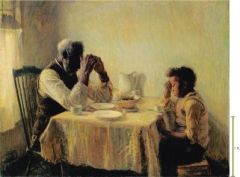
|
Tanner, The Thankful Poor, Realism Context: Oil on canvas Subject: Grandfather and boy, African American. Non-stereotypical, normalized. Meager meal with plates and cup positioned as would be. Composition: Background only includes wall, feels far enough away to be middle ground. Grandfather on left, boy on right. Style: Realistic, lots of dull and muted colors. |
|
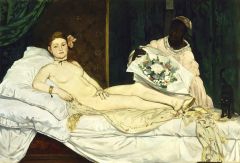
|
Manet, Olympia, Realism Context: Exhibited in Paris Salon Subject: Prostitute, hissing black cat. Unmarried. Composition: Woman in foreground, caretaker in background. Body facing towards us unashamed. Style: Realistic but not photographic, no shading on her body. Tight brushwork and strong line. |
|
|
What are some of the ways Modernism is understood and defined through the writings of Charles Baudelaire and Friedrich Nietzsche? *Most likely
|
Living in and representing the present. Baudelaire focused on how to do this in art with fashion, not clothing people in ancient Roman or Greek garb. For something to become an important "antique" it must represent the time which it comes from. Originality comes from the time it was made.
Nietzsche called for the same balance and not getting caught up in the "consumptive historical fever", talking about the cow that is forced to live in the present because of his lack of ability to remember the past. Obsess with history - crumble present - crumble past. Idea of loyalty to "true culture" even if it overthrows the ideas that make up the culture at the time. Morality and truth. |
|
|
Joyous Dead |
Baudelaire, The Joyous Dead, Realism Context: Written 1857, not commissioned. Representing of Baudelaire's tendency to discourage dwelling in the past Subject: Talking about death as a reality, not romanticized. "Testaments and tombs" hates dwelling on the past. Death to him a joyous release. Composition: Poem. No rhyming, broken into four stanzas of four or three lines. Does not particularly flow to reader. Style: Language not overly flowery, does speak symbolically. |
|
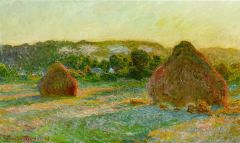
|
Monet, Haystacks, Impressionism Context: Oil on canvas, Normandy France countryside Subject: Two haystacks in a field, meant to "forget the object" and rid the mind of bias. Composition: One haystack more in foreground, one in middle ground, a small town landscape in the background. Perspective with the closer haystack larger. Style: Use of all colors, some in surprising locations. Light coming from behind, casting shadow toward the viewer. Not entirely photographic, loose brushwork. |
|
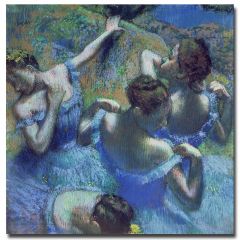
|
Degas, Blue Dancers, Impressionism Context: Pastel on paper Subject: Ballet dancers Composition: Foreground, bodies in movement, "cropped" style like photography Style: Bright colors, lots of colors mashed together, loose brushwork |
|
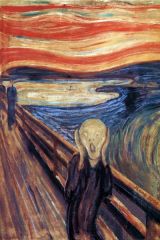
|
Munch, The Scream, Symbolism
Context: Oil, tempera, and pastel on cardboard Subject: Figure cupping ears, two others unaware. Rigid industrialized world, motion in nature. Humanity consumed by dehumanized society. Composition: Screamer in foreground, tall figures in background. Diagonal bridge. Style: High-pitched tones, loose brushwork, not realistic |
|
|
Love Song
|
Eliot, The Love Song of J. Alfred Prufrock, Modernism
Context: Written in 1920, not commissioned. Not representing the writer's own tendency, rather one of Prufrock Subject: City that is not very beautiful, light that moves like a cat across the buildings. A question he wants to ask to a woman, his own self-consciousness robs him of the time he thought he had. Rejection vs. not trying - which is greater risk? Ends up being lured to the darkness by a mermaid waking up to find out it's too late. Composition: Poem with some rhyming, broken into stanzas but not equal ones Style: Language seems pretty colloquial |
|
|
Rite of Spring
|
Stravinsky, The Rite of Spring, Modernism
Context: Ballet and orchestral work, performed at Theater of Champs Elysee Subject: Based on Pagan myths, girl chosen to dance herself to death as sacrifice to save group Composition: Many instruments and moving lines colliding and building on each other. Ballet. Style: High volume, some dynamic variance. Lots of dissonance and exhilarating chords. Timbre? |
|
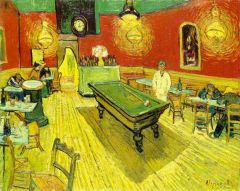
|
Van Gogh, The Night Café, Expressionism
Context: Oil on canvas Subject: Ugly on purpose to show ugliness of society, cafe - one can ruin oneself, go mad, commit crime Composition: Cartoonish, exaggerated perspective Style: Japanese influence, surpsing colors, colors as expression. |
|
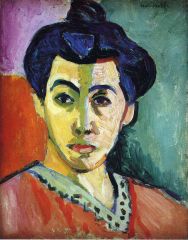
|
Matisse, Portrait of Mme. Matisse, Fauvism
Context: Oil on canvas. Not commissioned. Artist tendency to work with colors that don't seem to naturally go together. Subject: Depiction of his wife. Composition: Flat, all foreground with no depth or shading. Symbolism can be up to viewer's interpretation. Style: Planes of color that do not blend. Not photographic. No real light or shadow. |
|

|
Picasso, Portrait of Kahnweiler, Cubism
Context: Oil on canvas. Subject: Kahnweiler, and art gallery owner in France. Up to interpretation on symbols, highly experimental Composition: Kahnweiler in the middle, hands at the bottom. All foreground and looks flat yet has shading and dimension on the individual shapes. Style: Brown and gray, smoky looking. Not photographic or realistic. Light portions that highlight face and hands. Loose brushwork and blending with strong lines that create shapes. |
|
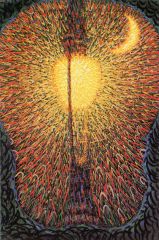
|
Balla, Street Light, Futurism
Context: Oil on canvas Subject: Symbolic of movement suggesting that "subjects less important than portrayal of 'dynamic sensation' of subject". Composition: Very flat, all in foreground, flat black background. lamp in center with "V" shaped light beams that point the eye to the center and create constant movement. Style: Complementary colors that make the eyes uneasy, unable to rest. Very visible brush strokes. Not meant to be photographic. |
|
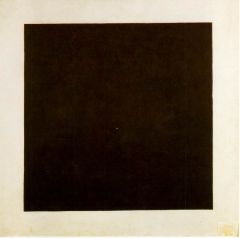
|
Malevich, Black Square, Suprematism
Context: Oil on linen, artist seeking to show "zero" and a non-objective art Subject: Black square, symbolic of his advancement on Cubism to the most reduced possible. Art as an idea, free from logic and reason. Composition: No visual texture, perfectly symmetrical. Blank canvas on edges. Style: Black, strong line on the edges. Perfectly symmetrical. Extreme reduction. |
|
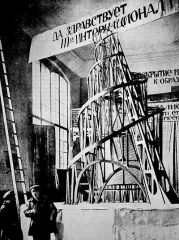
|
Tatlin, Monument to the Third International, Constructivism
Context: To be built in Russia, meant to be done in glass, steel, and iron. Subject: Building to represent aspirations of the country and trump the Eiffel tower by 1/3 Composition: Ascending circling tower, decreasing in size at the top. Multiple trusses to support weight. Style: Spiraling, leaning form with geometric shapes. Silver and gray. |
|

|
Rietveld, The Rietveld-Schroder House, De Stijl
Context: Commissioned to be built for Mrs Schroder. Walls brick and plaster, doors and window frames wood. Steel beams inside to hold it up and columns. Subject: "line and color" functional and simple. Schroder wanted it to be sober and active and multi-functional. Composition: Flexible spatial arrangement. Style: Red, gray, yellow in blocks. Rigid lines and boxy architecture. Abstract planes, projecting roof and balcony. |
|
|
What effect did the invention of photography have on art in the late-19th Century?
|
No need to paint exactly what is being seen, etc.
|

